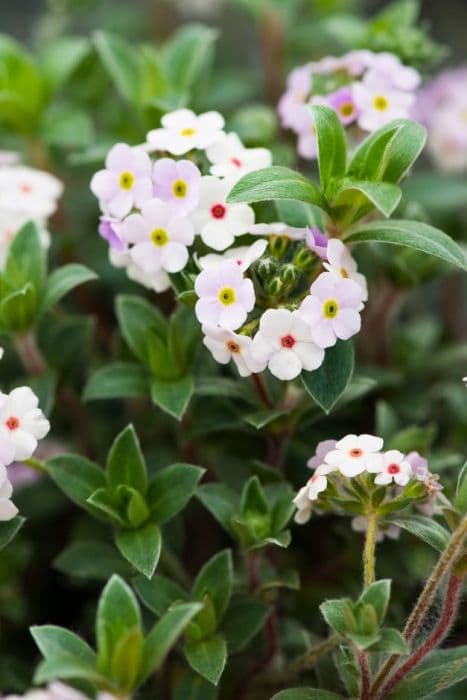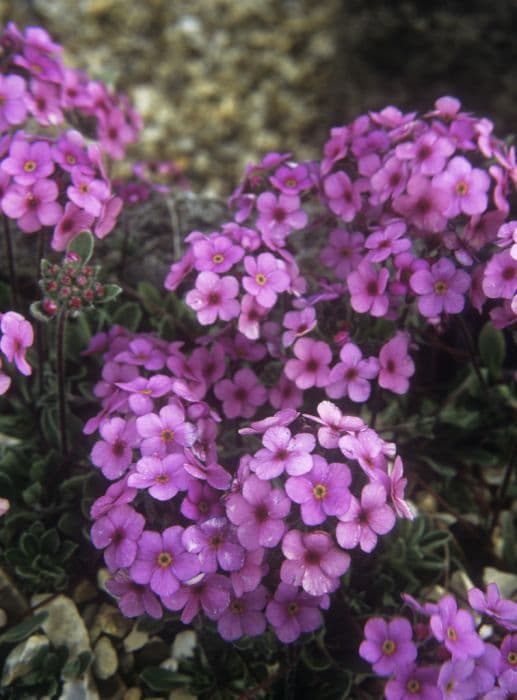Auricula Primula auricula 'Pinstripe' (Au/st)

ABOUT
The Primula auricula 'Pinstripe' is a captivating plant known for its distinctive and showy flowers. These blooms present a striking combination of colors, typically featuring a deep, velvety purple habitat with a prominent, creamy yellow to white center. This central area, often referred to as the 'eye,' is surrounded by a band or series of bands that possess a contrasting pinstripe pattern, hence the name 'Pinstripe'. The petals themselves are rounded, with smooth edges, characteristically overlapping each other to form a circular outline. Adding to its allure, the leaves of the Primula auricula 'Pinstripe' contribute a lush backdrop to the vivid blossoms. They are typically a bright, fresh green, which contrasts beautifully with the darker tones of the flowers. Their texture is often described as fleshy or leathery, and they can sometimes have a slightly powdery coating that protects them from pests. The foliage forms a rosette at the base of the plant, creating a neat and organized appearance that complements the blossoms' bold display. Collectively, the plant exudes a charming and old-fashioned cottage garden aesthetic, making it a prized possession amongst garden enthusiasts who are drawn to its unique and decorative appearance. It's well-loved not only for its visual appeal but also for its ability to bring a touch of elegance and drama to any garden setting.
About this plant
 Names
NamesFamily
Primulaceae
Synonyms
Auricula, Mountain Cowslip, Bear's Ear
Common names
Primula auricula 'Pinstripe'.
 Toxicity
ToxicityTo humans
The Primula auricula, commonly known as Bear's Ear, is generally not considered toxic to humans. However, like many plants, it may cause mild irritation to the skin or stomach if ingested or handled, especially in sensitive individuals. It is not known for containing any significant toxins that would lead to serious poisoning or severe effects upon ingestion.
To pets
The Primula auricula, commonly known as Bear's Ear, has not been reported as toxic to pets. Although it might cause mild gastrointestinal upset if ingested in large quantities due to the plant's natural compounds, it is generally considered safe. There is no widespread evidence of serious toxicity in domestic animals such as cats and dogs from consuming Bear's Ear.
 Characteristics
CharacteristicsLife cycle
Perennials
Foliage type
Evergreen
Color of leaves
Green
Flower color
Mixed
Height
6 inches (15 cm)
Spread
6 inches (15 cm)
Plant type
Herb
Hardiness zones
5
Native area
Europe
Benefits
 General Benefits
General Benefits- Aesthetic Appeal: The Primula auricula 'Pinstripe' (often referred to as Auricula) adds visual interest to gardens with its unique pinstripe-patterned flowers in vibrant colors.
- Compact Size: Suitable for small gardens or container planting due to its compact growth habit.
- Spring Bloomer: Provides early blooming in spring, adding color to gardens after the winter season.
- Attracts Pollinators: Helps support local ecosystems by attracting bees and other pollinators.
- Easy to Grow: Known for being low maintenance and easy to care for, making it ideal for novice gardeners.
- Cold Tolerant: Exhibits good cold resistance, fitting for gardens in cooler climates.
- Versatile Usage: Can be planted in borders, rockeries, or used in alpine displays, providing flexibility in garden design and landscaping.
- Long Blooming Season: Offers a relatively long flowering period in comparison to many other plants, extending the display of color in gardens.
- Heritage Variety: As an heirloom species, it can provide historical interest and conservation value to gardens.
- Propagates Easily: Can be easily propagated, allowing gardeners to increase their collection without additional costs.
 Medical Properties
Medical PropertiesThis plant is not used for medical purposes.
 Air-purifying Qualities
Air-purifying QualitiesThis plant is not specifically known for air purifying qualities.
 Other Uses
Other Uses- Perfume: The auricula flowers are sometimes used in the perfume industry for their sweet, delicate fragrance.
- Photography: Auriculas, with their unique patterns and colors, are often photographed by plant enthusiasts and used in botanical art and photography projects.
- Greeting Cards: The distinctive appearance of auriculas makes them a popular image on greeting cards, particularly those themed around spring or gardens.
- Culinary Decoration: The flowers of auriculas can be used as a decorative edible garnish for desserts and other dishes due to their vibrant colors.
- Dye: Auricula petals, especially the darker hues, can be used to create natural dyes for fabrics or crafts.
- Educational Tools: Auriculas can be valuable teaching tools in botany and horticulture classes due to their interesting genetic variations and propagation techniques.
- Theater Props: Due to their distinct look, auriculas can be featured in theatrical productions, especially those set in historical times, as props or stage decorations.
- Collectors' Item: The uniqueness of each auricula flower can make them a sought-after item for plant collectors and enthusiasts who value their rarity and beauty.
- Theme Gardens: Auriculas can serve as a theme for a garden, creating a focused display around these plants, known as auricula theaters, which are specially designed tiered staging for displaying the plants.
- Seed Trading: Hobbyists often engage in seed trading or sharing of auricula seeds to propagate and spread the plant's unique varieties to other enthusiasts.
Interesting Facts
 Feng Shui
Feng ShuiThe Auricula is not used in Feng Shui practice.
 Zodiac Sign Compitability
Zodiac Sign CompitabilityThe Auricula is not used in astrology practice.
 Plant Symbolism
Plant Symbolism- Unique Beauty: The 'Pinstripe' pattern of Primula auricula represents its distinctive beauty, distinguishing it from other flowers.
- Perseverance and Resilience: As a plant that can thrive in alpine regions, it symbolizes the ability to endure challenging conditions.
- Precision and Attention to Detail: The precise pattern on its petals is reflective of nature's meticulous craftsmanship and may inspire similar qualities in the observer.
- Favor and Admiration: Often grown and nurtured by enthusiasts, Primula auricula is a symbol of favoritism and the admiration of selective beauty.
 Water
WaterThe Primula auricula 'Pinstripe', commonly known as Auricula Primrose, should be watered deeply but infrequently, maintaining moderately moist soil. Generally, it’s advisable to water the plant with about one to two gallons every week, adjusting the frequency based on weather conditions, with less water needed during cool, wet periods and more during hot, dry spells. It’s best to water at the base of the plant, avoiding wetting the foliage to prevent fungal diseases. During the winter, when the plant is dormant, reduce watering significantly, providing only enough to prevent the soil from completely drying out. Be sure to allow the top inch of soil to dry out between waterings to encourage strong root growth and avoid waterlogging.
 Light
LightAuricula Primrose thrives in bright, indirect sunlight or partial shade, making it ideal for an east-facing garden where it can be protected from the intense heat of the afternoon sun. It can tolerate morning light well but should be shaded during the hottest part of the day. Thus, a spot that receives filtered light or a few hours of direct sun followed by dappled shade is perfect for maintaining the vibrant colors of the blooms without causing stress to the plant.
 Temperature
TemperatureAuricula Primrose prefers cooler temperatures, with ideal growing conditions ranging between 50°F and 70°F. They can survive brief periods of colder weather, with a minimum temperature threshold of around 20°F, and they can manage in temperatures up to about 80°F, but prolonged heat can be detrimental. During hot summers, it's essential to provide extra shade and protection to prevent heat stress.
 Pruning
PruningThe Auricula Primrose benefits from occasional deadheading and removal of spent flowers to encourage further blooming and to maintain a neat appearance. Pruning should take place right after the blooms fade, usually in late spring or early summer. Also, remove any damaged or diseased leaves as they appear to keep the plant healthy. Pruning will not be necessary more than a couple of times each season, typically after each bloom cycle.
 Cleaning
CleaningAs needed
 Soil
SoilAuricula Primrose thrives in well-draining, slightly damp soil with a pH around 6.0 to 7.5. A mix containing peat, perlite, and loam works well to maintain balanced moisture and nutrients.
 Repotting
RepottingAuricula Primrose should be repotted every one to two years to replenish the soil and encourage healthy growth, ideally in the spring after flowering.
 Humidity & Misting
Humidity & MistingAuricula Primrose prefers moderate humidity levels but can tolerate a range from 50% to 75%, avoiding overly dry or damp conditions that could damage the plant.
 Suitable locations
Suitable locationsIndoor
Place Auricula Primrose in bright, indirect light with good ventilation.
Outdoor
Position Auricula Primrose in dappled sunlight, shelter from intense midday sun.
Hardiness zone
Auricula Primrose is suitable for 4-8 USDA.
 Life cycle
Life cycleThe life of 'Pinstripe' Auricula (Primula auricula 'Pinstripe') begins with seed germination, occurring in moist, well-drained soil under cool conditions. Seedlings emerge and develop into rosettes of succulent-like leaves, a growth form that persists through the plant's life. During the spring, typically in its second year, the Auricula produces tall flowering stems bearing clusters of ornate, patterned flowers that are the plant's namesake. After pollination, often by insects, the flowers develop into capsules filled with tiny seeds. Once the seeds mature, they are dispersed by wind, water, or animal activity, which initiates new cycles of germination. In favorable conditions, Auriculas may also spread vegetatively through offshoots from the main plant, thus contributing to the perennial aspect of their life cycle.
 Propogation
PropogationPropogation time
Spring to Summer
Propogation: The popular method for propagating the Primula auricula, also known as Auricula, is through division, preferably carried out after the flowering period at the beginning of autumn. Division helps maintain the plant's vigor and allows gardeners to multiply their plants. The process involves gently lifting the entire plant from the ground, shaking off any excess soil, and carefully separating the plant into smaller sections, making sure each new piece has roots attached. The divisions are then immediately replanted in well-draining soil at the same depth they were growing previously, and watered thoroughly to help settle the roots. It's important that the new divisions are kept in a shaded location for a few weeks to minimize the stress of transplanting and to allow them to establish themselves without the harsh effects of direct sunlight.









